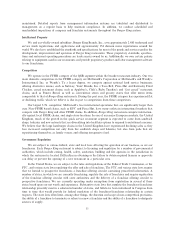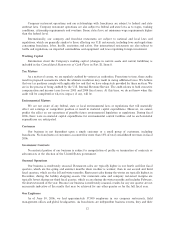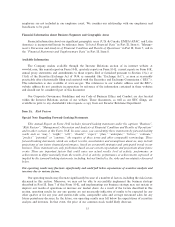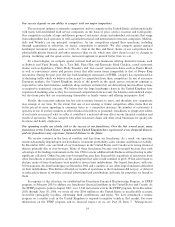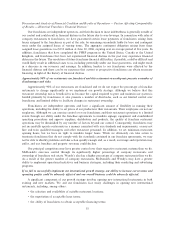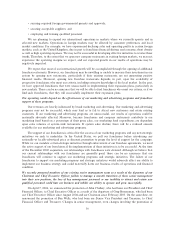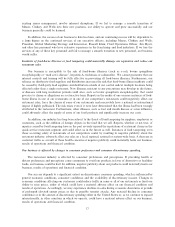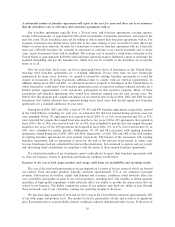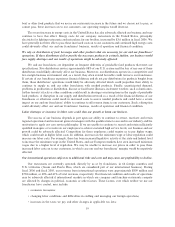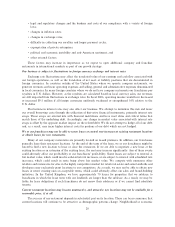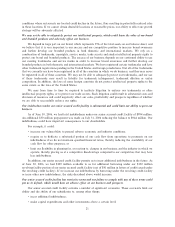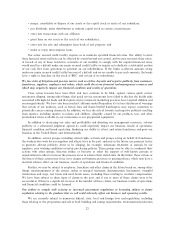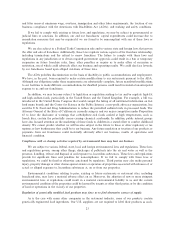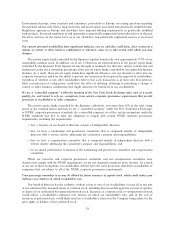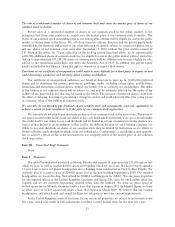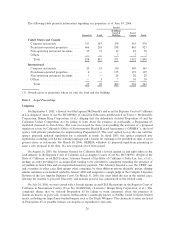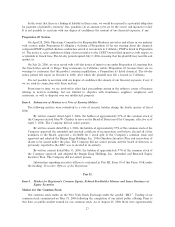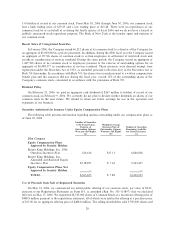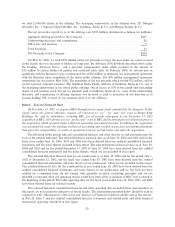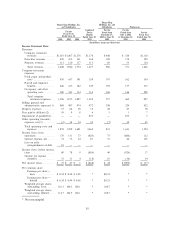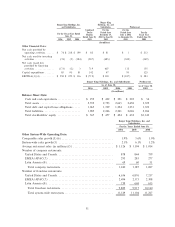Burger King 2006 Annual Report Download - page 33
Download and view the complete annual report
Please find page 33 of the 2006 Burger King annual report below. You can navigate through the pages in the report by either clicking on the pages listed below, or by using the keyword search tool below to find specific information within the annual report.conditions where restaurants are located could decline in the future, thus resulting in potentially reduced sales
in these locations. If we cannot obtain desirable locations at reasonable prices, our ability to effect our growth
strategy will be adversely affected.
We may not be able to adequately protect our intellectual property, which could harm the value of our brand
and branded products and adversely affect our business.
We depend in large part on our brand, which represents 35% of the total assets on our balance sheet, and
we believe that it is very important to our success and our competitive position to increase brand awareness
and further develop our branded products in both domestic and international markets. We rely on a
combination of trademarks, copyrights, service marks, trade secrets and similar intellectual property rights to
protect our brand and branded products. The success of our business depends on our continued ability to use
our existing trademarks and service marks in order to increase brand awareness and further develop our
branded products in both domestic and international markets. We have registered certain trademarks and have
other trademark registrations pending in the United States and foreign jurisdictions. Not all of the trademarks
that we currently use have been registered in all of the countries in which we do business, and they may never
be registered in all of these countries. We may not be able to adequately protect our trademarks, and our use
of these trademarks may result in liability for trademark infringement, trademark dilution or unfair
competition. In addition, the laws of some foreign countries do not protect intellectual property rights to the
same extent as the laws of the United States.
We may from time to time be required to institute litigation to enforce our trademarks or other
intellectual property rights, or to protect our trade secrets. Such litigation could result in substantial costs and
diversion of resources and could negatively affect our sales, profitability and prospects regardless of whether
we are able to successfully enforce our rights.
Our indebtedness under our senior secured credit facility is substantial and could limit our ability to grow our
business.
As of June 30, 2006, we had total indebtedness under our senior secured credit facility of $994 million.
An additional $50 million prepayment was made on July 31, 2006 reducing the balance to $944 million. Our
indebtedness could have important consequences to our shareholders.
For example, it could:
‚ increase our vulnerability to general adverse economic and industry conditions;
‚ require us to dedicate a substantial portion of our cash flow from operations to payments on our
indebtedness if we do not maintain specified financial ratios, thereby reducing the availability of our
cash flow for other purposes; or
‚ limit our flexibility in planning for, or reacting to, changes in our business and the industry in which we
operate, thereby placing us at a competitive disadvantage compared to our competitors that may have
less indebtedness.
In addition, our senior secured credit facility permits us to incur additional indebtedness in the future. As
of June 30, 2006, we had $109 million available to us for additional borrowing under our $150 million
revolving facility portion of our senior secured credit facility (net of $41 million in letters of credit issued under
the revolving credit facility). If we increase our indebtedness by borrowing under the revolving credit facility
or incur other new indebtedness, the risks described above would increase.
Our senior secured credit facility has restrictive terms and our failure to comply with any of these terms could
put us in default, which would have an adverse effect on our business and prospects.
Our senior secured credit facility contains a number of significant covenants. These covenants limit our
ability and the ability of our subsidiaries to, among other things:
‚ incur additional indebtedness;
‚ make capital expenditures and other investments above a certain level;
21


